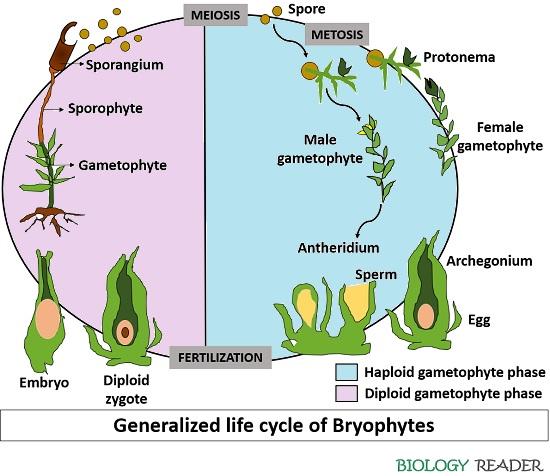The life cycle of bryophytes has two alternations of generations, one is haploid gametophyte generation, and the other is diploid saprophytic generation. In both the life cycle, the bryophytes possess different morphology and physiological functions. The haploid gametophyte phase lasts longer or dominates the diploid saprophytic phase between these two alternations of generations.
Heterosporous bryophytes hold two types of spores that develop gametophytes, in which one spore develops a male gametophyte, and the other develops a female gametophyte. Besides reproduction through spores, bryophytes may also reproduce via vegetative structures or gemmae.
They represent the group of non-vascular lant plants, which include liverworts, mosses and hornworts. One characteristic feature of bryophytes is that they possess unbranched sporophytes. This post describes the meaning and two different phases in the life cycle of bryophytes.
Content: Life Cycle of Bryophytes
Meaning of Bryophytes
Bryophytes are terrestrial and non-vascular plants that grow in damp or humid habitats and reproduce via spore generation instead of seed germination. Mosses, hornworts, and liverworts are the three common plants that come under the bryophyte group. There is one thing common among the non-vascular plants (mosses, liverworts and hornworts) that all possess small leaves. However, bryophytes lack flowers, wood and a true root system.
In addition, bryophytes possess dual generations (gametophytic and sporophytic phases) in their life cycle. Unlike vascular plants, bryophytes can survive in various habitats (rocks, roofs, bare soil etc.). They lack true roots for water and nutrient absorption.
Life Cycle
Bryophytes reproduce through both asexual and sexual means. They reproduce asexually via gemmae formation or fragmentation. Conversely, their sexual reproduction occurs via two different types of spores that form anthrezoids and archaegonia.
Asexual Reproduction of Bryophytes
Some bryophytes only undergo asexual reproduction or cannot achieve fertilization due to loss of functional sexuality.
- Vegetative reproduction occurs via reproductive structures called gemmae that disperse easily. Gemmae comprise either a single cell or cluster of cells that are having undifferentiated growth. A gemma can form a new vegetative structure or gametophyte when it dissociates from the parent plant body.
- Fragmentation is another way of asexual reproduction by which bryophytes can regenerate via leaf and stem fragments. The mechanism of spore dispersal and fragmentation is aided by water, wind, and animal movement.
Sexual Reproduction of Bryophytes
It exists in two phases that are explained below:

Gametophyte Stage
This stage begins when the dormant spores of bryophytes form a germ tube. Spores first develop a green and filiform complex called a protonema. Then, the protonema goes through several maturation phases, after which it starts developing rhizoids and aerial filaments.
Red light and kinetin stimulate the cells, promoting the growth of shoots, which later enlarge and modify into mature gametophytes. Then, gametophytes develop a specialized reproductive structure (gametangia) at the apex of the main shoot, which holds the gametes (eggs and sperms).
The leafy gametophyte develops separate branches for the male gametangium (antheridium) and the female gametangium (archegonium). Upper branches produce male antheridia that hold antherozoids or sperms, while the female archegonium carries a single egg or archaegonia.
Before fertilization, anthrezoids of the male gametangium of the same or different plants go down to the archaegonium via water droplets. There is a unique feature where both the gametangia of bryophytes are enclosed by a sterile layer of non-reproductive tissues that is absent in algal gametangia.
Sporophyte Stage
It begins with the fusion of a biflagellate sperm and an ovum inside the archegonium. After fusion, nuclear and cytoplasmic exchange occurs between anthrezoids and archegonia, resulting in the formation of the diploid zygote (2n), and the process is called fertilization.
In bryophytes, a biflagellate sperm goes down to the archegonium via a passage of water film on the plant surface. A diploid zygote in the archegonium develops into a multicellular diploid embryo by undergoing repeated mitotic divisions. An embryonic sporophyte highly relies on the gametophyte that provides nutrition sources like sugars, minerals, etc.
An embryonic sporophyte differentiates into three distinct structures, namely foot, stalk, and capsule. The foot provides a base to anchor the young sporophyte. A stalk appears as a slender filament that attaches to the sporangium and originates from the foot cell.
A spore capsule appears as a tight cap (calyptra) that comprises a layer of sterile protective cells around an embryonic sporophyte at the opposite end of the foot. A spore capsule encloses a sporangium sac that holds the heterospores, which function as sexual dispersal units. The spore-producing cells go through meiotic cell division to form spores (haploid).
The spore formation occurs when the foot cell uptakes nutrients from the gametophyte and conducts them to the spore capsule via a long stalk or seta. A spore capsule comprises a layer of sterile cells and a hygroscopic layer of elaters that absorbs moisture from the surrounding.
The hydrogroscopic movement of the cells within the spore capsule results in the flicking of the spores upward and outward. Unfortunately, the spore capsule ruptures as the spores attain maturity. Spores move freely in the environment as dormant spores. The life cycle of bryophytes continues once the dormant spore starts germinating into protonema.
Conclusion
Therefore, we can conclude that the gametophyte phase contains haploid cells that possess an unpaired number of chromosomes. In contrast, the saprophyte phase includes diploid cells that possess two sets of paired chromosomes. The gametophyte phase occurs predominantly in all the bryophytes and lasts longer.